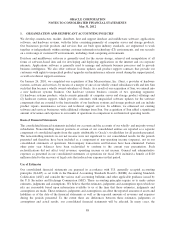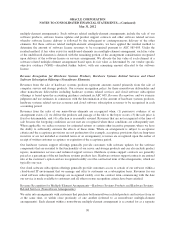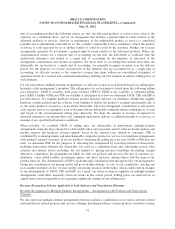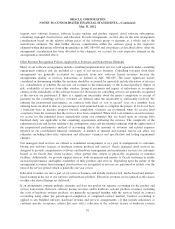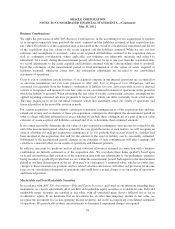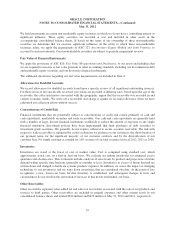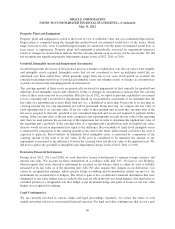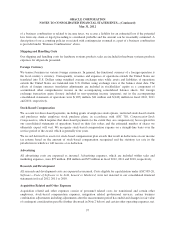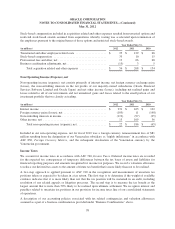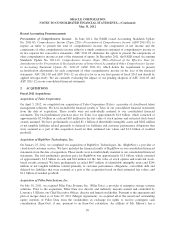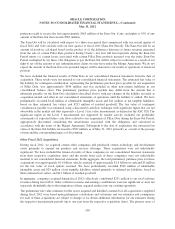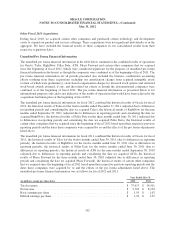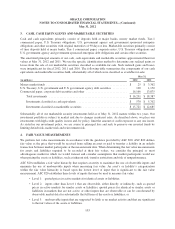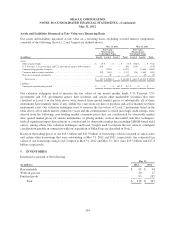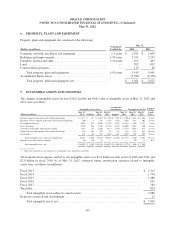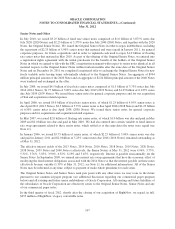Oracle 2012 Annual Report Download - page 102
Download and view the complete annual report
Please find page 102 of the 2012 Oracle annual report below. You can navigate through the pages in the report by either clicking on the pages listed below, or by using the keyword search tool below to find specific information within the annual report.
ORACLE CORPORATION
NOTES TO CONSOLIDATED FINANCIAL STATEMENTS—(Continued)
May 31, 2012
Stock-based compensation included in acquisition related and other expenses resulted from unvested options and
restricted stock-based awards assumed from acquisitions whereby vesting was accelerated upon termination of
the employees pursuant to the original terms of those options and restricted stock-based awards.
Year Ended May 31,
(in millions) 2012 2011 2010
Transitional and other employee related costs ..................... $ 25 $ 129 $ 66
Stock-based compensation .................................... 33 10 15
Professional fees and other, net ................................. 13 66 68
Business combination adjustments, net ........................... (15) 3 5
Total acquisition related and other expenses .................. $ 56 $ 208 $ 154
Non-Operating Income (Expense), net
Non-operating income (expense), net consists primarily of interest income, net foreign currency exchange gains
(losses), the noncontrolling interests in the net profits of our majority-owned subsidiaries (Oracle Financial
Services Software Limited and Oracle Japan) and net other income (losses), including net realized gains and
losses related to all of our investments and net unrealized gains and losses related to the small portion of our
investment portfolio that we classify as trading.
Year Ended May 31,
(in millions) 2012 2011 2010
Interest income ............................................. $ 231 $ 163 $ 122
Foreign currency gains (losses), net ............................. (105) 11 (148)
Noncontrolling interests in income .............................. (119) (97) (95)
Other income, net ........................................... 15 109 56
Total non-operating income (expense), net .................... $ 22 $ 186 $ (65)
Included in our non-operating expense, net for fiscal 2010 was a foreign currency remeasurement loss of $81
million resulting from the designation of our Venezuelan subsidiary as “highly inflationary” in accordance with
ASC 830, Foreign Currency Matters, and the subsequent devaluation of the Venezuelan currency by the
Venezuelan government.
Income Taxes
We account for income taxes in accordance with ASC 740, Income Taxes. Deferred income taxes are recorded
for the expected tax consequences of temporary differences between the tax bases of assets and liabilities for
financial reporting purposes and amounts recognized for income tax purposes. We record a valuation allowance
to reduce our deferred tax assets to the amount of future tax benefit that is more likely than not to be realized.
A two-step approach is applied pursuant to ASC 740 in the recognition and measurement of uncertain tax
positions taken or expected to be taken in a tax return. The first step is to determine if the weight of available
evidence indicates that it is more likely than not that the tax position will be sustained in an audit, including
resolution of any related appeals or litigation processes. The second step is to measure the tax benefit as the
largest amount that is more than 50% likely to be realized upon ultimate settlement. We recognize interest and
penalties related to uncertain tax positions in our provision for income taxes line of our consolidated statements
of operations.
A description of our accounting policies associated with tax related contingencies and valuation allowances
assumed as a part of a business combination is provided under “Business Combinations” above.
98


